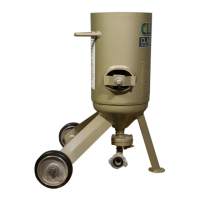MODELS 1028 & 1042 BLAST MACHINES Page 6
© 2013 CLEMCO INDUSTRIES CORP. www.clemcoindustries.com Manual No. 04124, Rev. K
3.3 Manual Blasting. Refer to Section 3.4 for
blasting with remote controls.
3.3.1 Make sure the ventilation system is running.
3.3.2 Make sure the nozzle fixture is secure and that
the nozzle is directed only toward objects intended to be
blast cleaned.
WARNING
OSHA requires remote controls on all blast
machines when an operator controls the nozzle.
Ignoring this warning places the operator at
risk of severe injury or death from accidents
that could occur from an uncontrolled blast
nozzle.
3.3.3 Make sure the blasting area is contained.
WARNING
Abrasive blasting produces harmful dust.
Everyone exposed to blasting dust must wear a
properly-fitted and properly-maintained NIOSH-
approved, respiratory protection appropriate for
the job site hazards. Loud noise generated by
the use of compressed air could cause hearing
damage. Everyone exposed to the noise must
wear approved hearing protection.
3.3.4 The machine tender closes the outlet valve, and
while standing back and facing away from the concave
filling head, opens the inlet valve. This action causes the
pop-up valve to seal off the filling port and pressurizes
the blast machine.
3.3.5 If the abrasive metering valve is closed as
instructed in Section 3.2.6, only air will exit the nozzle.
Adjust the metering valve per Section 3.5.
WARNING
Never leave a pressurized machine unattended.
If an emergency occurs, such as a burst blast
hose, shut-down the machine immediately.
3.3.6 To stop blasting, the machine tender closes the
inlet valve, and while standing back and facing away
from the concave head and outlet valve, quickly opens
the outlet valve. The pop-up valve drops when air is
expelled from the machine and pressure equalizes.
3.4 Blasting with Remote Controls. Refer to
Section 3.3 for manually-controlled blasting.
3.4.1 Refer to the remote control manual to ensure
the machine is correctly set-up and ready for blasting.
3.4.2 Blasting Attire
3.4.2.1 Operators and anyone else that may be
exposed to the hazards generated by the blasting
process must wear appropriate protective gear,
including abrasive-resistant clothing, leather gloves, eye
and hearing protection, and a NIOSH-approved Type CE
Supplied-Air Respirator.
WARNING
Before blasting, test the coating and substrate
for toxic materials (such as lead or other heavy
metals, or asbestos). These hazards require
special measures to protect the operators and
the environment.
No dust is safe to breathe. Abrasive blasting
produces harmful dust. Failure to wear
approved respirators could result in serious
lung disease or death. Blast operators must
wear properly-fitted and maintained NIOSH-
approved, type-CE supplied-air respirators
approved for abrasive blasting.
During abrasive blasting, abrasive particles and
dust in the area around the blast machine and
blast nozzle become airborne. Everyone
working in the vicinity of abrasive blasting must
wear properly-maintained, NIOSH-approved,
respiratory protection and eye protection
appropriate for the job site hazards.
Loud noise generated by the use of
compressed air could cause hearing damage.
Everyone in the blasting area must wear
approved hearing protection.
3.4.3 Close the safety petcock located on the inlet
valve. Air should now be heard escaping from the orifice
under the control handle lever, but from no other place.
3.4.4 Pull back the safety lever lock under the control
handle lever.
3.4.5 Point the nozzle only toward objects intended to
be blast cleaned.
3.4.6 While holding the lever lock down, press the
control handle lever. Be prepared; blasting will begin as
soon as the machine pressurizes.

